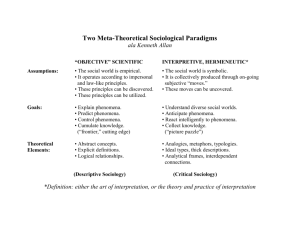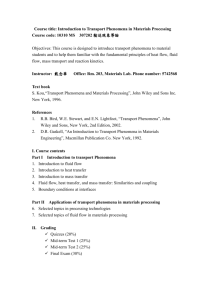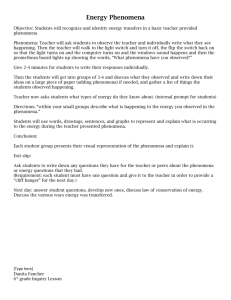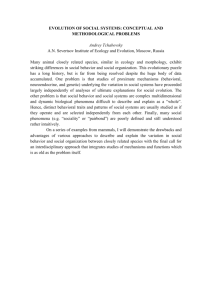52:144 TRANSPORT PHENOMENA
advertisement
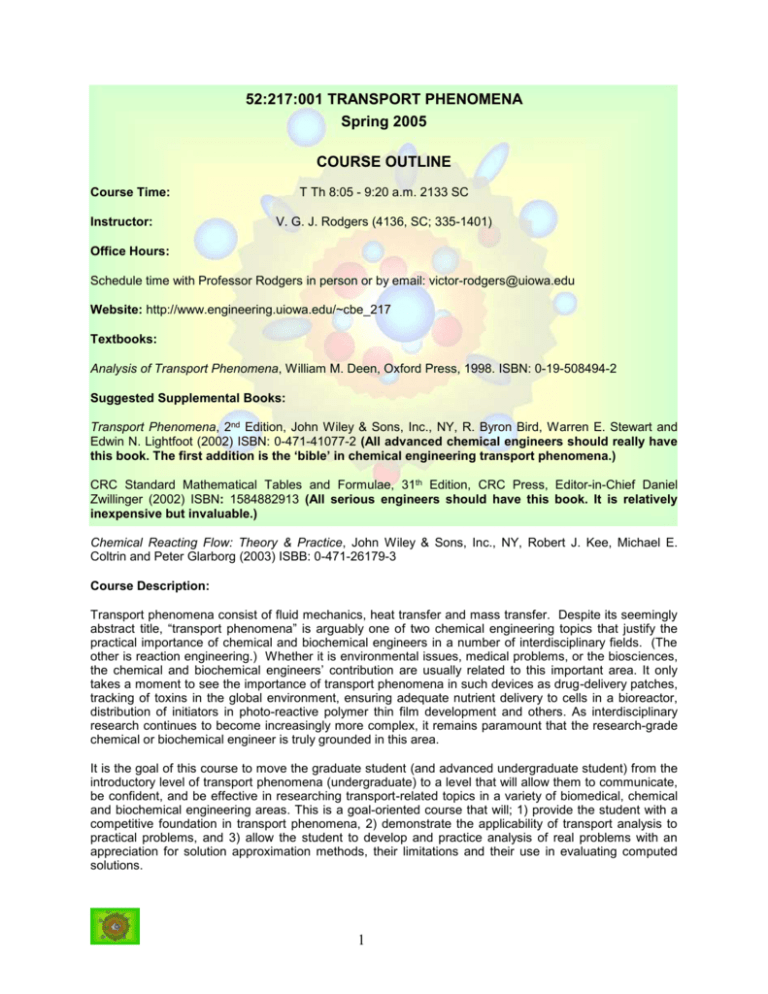
52:217:001 TRANSPORT PHENOMENA Spring 2005 COURSE OUTLINE Course Time: Instructor: T Th 8:05 - 9:20 a.m. 2133 SC V. G. J. Rodgers (4136, SC; 335-1401) Office Hours: Schedule time with Professor Rodgers in person or by email: victor-rodgers@uiowa.edu Website: http://www.engineering.uiowa.edu/~cbe_217 Textbooks: Analysis of Transport Phenomena, William M. Deen, Oxford Press, 1998. ISBN: 0-19-508494-2 Suggested Supplemental Books: Transport Phenomena, 2nd Edition, John Wiley & Sons, Inc., NY, R. Byron Bird, Warren E. Stewart and Edwin N. Lightfoot (2002) ISBN: 0-471-41077-2 (All advanced chemical engineers should really have this book. The first addition is the ‘bible’ in chemical engineering transport phenomena.) CRC Standard Mathematical Tables and Formulae, 31th Edition, CRC Press, Editor-in-Chief Daniel Zwillinger (2002) ISBN: 1584882913 (All serious engineers should have this book. It is relatively inexpensive but invaluable.) Chemical Reacting Flow: Theory & Practice, John Wiley & Sons, Inc., NY, Robert J. Kee, Michael E. Coltrin and Peter Glarborg (2003) ISBB: 0-471-26179-3 Course Description: Transport phenomena consist of fluid mechanics, heat transfer and mass transfer. Despite its seemingly abstract title, “transport phenomena” is arguably one of two chemical engineering topics that justify the practical importance of chemical and biochemical engineers in a number of interdisciplinary fields. (The other is reaction engineering.) Whether it is environmental issues, medical problems, or the biosciences, the chemical and biochemical engineers’ contribution are usually related to this important area. It only takes a moment to see the importance of transport phenomena in such devices as drug-delivery patches, tracking of toxins in the global environment, ensuring adequate nutrient delivery to cells in a bioreactor, distribution of initiators in photo-reactive polymer thin film development and others. As interdisciplinary research continues to become increasingly more complex, it remains paramount that the research-grade chemical or biochemical engineer is truly grounded in this area. It is the goal of this course to move the graduate student (and advanced undergraduate student) from the introductory level of transport phenomena (undergraduate) to a level that will allow them to communicate, be confident, and be effective in researching transport-related topics in a variety of biomedical, chemical and biochemical engineering areas. This is a goal-oriented course that will; 1) provide the student with a competitive foundation in transport phenomena, 2) demonstrate the applicability of transport analysis to practical problems, and 3) allow the student to develop and practice analysis of real problems with an appreciation for solution approximation methods, their limitations and their use in evaluating computed solutions. 1 1 Because transport phenomena are based on the conservation laws, they naturally require the language of mathematics. Therefore it is assumed that the student has had a basic foundation in solutions to ordinary linear differential equations and an elementary course in vector analysis. Tensor notation will be used throughout the class. This is important because often times, difficult problems are of arbitrary geometries and do not have a convenient coordinate system. However, a review of vector and tensor algebra and calculus will be provided. Nevertheless, it is the physical interpretation of the problem that will be emphasized via the appreciation of the problem’s mathematical form. An emphasis will also be placed on illuminating the similarities in a variety of different problems due to their mathematical similarities. Thus this course will be presented in several basic parts; introduction to vector and tensor analysis, the conservation equations, dimensionless analysis, conduction and diffusion, fluid mechanics, heat transfer and mass transfer. The book Analysis of Transport Phenomena and the class notes will be used throughout the course. Generally, the class notes will guide the class structure with the textbook used as an important reference. Many of the problems in the text are presented from the tensor notation perspective and the physical meaning or the differential equation form, the constitutive equations, boundary condition assumptions and solution are emphasized. Advanced topics in the text will be addressed in this course. Useful analytical and numerical mathematical techniques will be developed to solve classical problems of the partial differential form. This is a goal-orientated course, and, as such, it is project based. However, so that the student has formal development of fundamental training, three closed-book exams (Confidence Builders) are offered with one ongoing, project that will be due at the end of the semester. The project will be based on one suggested by the student on a problem of significance to the student. The project goals will be introduced early on in the course and it will be approved by Professor Rodgers. The project will require the graduate student to develop and, then, solve, a tractable problem related to an area of their interest (this may be their research area). A series of short presentations will be used for the student to develop the project as well as share with the class what they are doing. The final professional report and presentation of the project are due at the end of the semester. The homework will be reviewed with the primary concern being effort and professionalism rather than correctness. This is because the philosophy of graduate education is to develop the ability to teach ourselves new subject matter and to be accountable for our technical performance. Thus students will not be penalized for incorrectness during the “intermediate stages” of learning (homework) but they will be accountable for knowing the correct approach to a problem in the exams. Therefore it is essential to the student that they are responsible for their understanding of the problems and their assigned purpose. Keep in mind that the purpose of this course is to help you become experts in chemical engineering so that you are competitive with entry-level doctoral recipients throughout the world. It is not designed to weed you out of our graduate program. Therefore this course will be rigorous. However it will be in a supportive setting. To this end, I will have an open-door policy for help and support with any aspect of this course. Take advantage of soliciting for help as often as necessary. Answers to the homework will be made available on the website for the course the day after the homework is due. No homework will be accepted late. Because growth is essential, the closed-book exams will be weighed on an increasing scale with the project counting significantly to the final grade. Professional and technical qualities are of the utmost importance. Exam Schedule and Grading: EXAM Presentation I (Preliminary) 1st Confidence Builder 2rd Confidence Builder Presentation II (Intermediate) 3rd Confidence Builder Presentation Project Due TOTAL POINT 100 200 300 150 400 200 500 DATE and DATE Saturday, February 12, 2005 Tuesday, February 17, 2005 Thursday, March 24, 2005 Saturday, April 9, 2005 May 5, 2005 Noon, Friday, May 13, 2005 Noon, Friday, May 13, 2005 1850 2 2 Collaboration Policy: Any questions about homework problems should be addressed to Professor Rodgers. Discussion of homework problems with other students in the class is acceptable but direct copying of complete or part of an assignment is not allowed. Cheating on exams and/or plagiarism in projects will result in an F grade given for the course. TOPICS VECTOR FIELD THEORY NOTES AND APPENDIX Vector and vector operations Gradients Curvilinear coordinates Fluid velocity Divergence, curl and gradient Divergence theorem Continuity equation Stokes theorem and meaning of curl Dyads: algebra and calculus DIFFUSIVE FLUXES AND MATERIAL PROPERTIES CH. 1 CONSERVATION EQUATIONS CH. 2 FUNDAMENTALS OF HEAT AND MASS TRANSFER CH. 2 SCALING AND DIMENSIONLESS ANALYSIS CH. 3 AND NOTES ANALYTICAL METHODS FOR SOLVING CONDUCTION AND DIFFUSION PROBLEMS CH. 4 MOMENTUM Fundamentals Unidirectional Flow Creeping Flow Flow at High Reynolds Numbers CH. 5 CH. 6 CH. 7 CH. 8 FORCED CONVECTION IN LAMINAR FLOW Confined Unconfined CH. 9 CH. 10 MULTICOMPONENT ENERGY AND MASS TRANSFER 3 3 CH. 11

